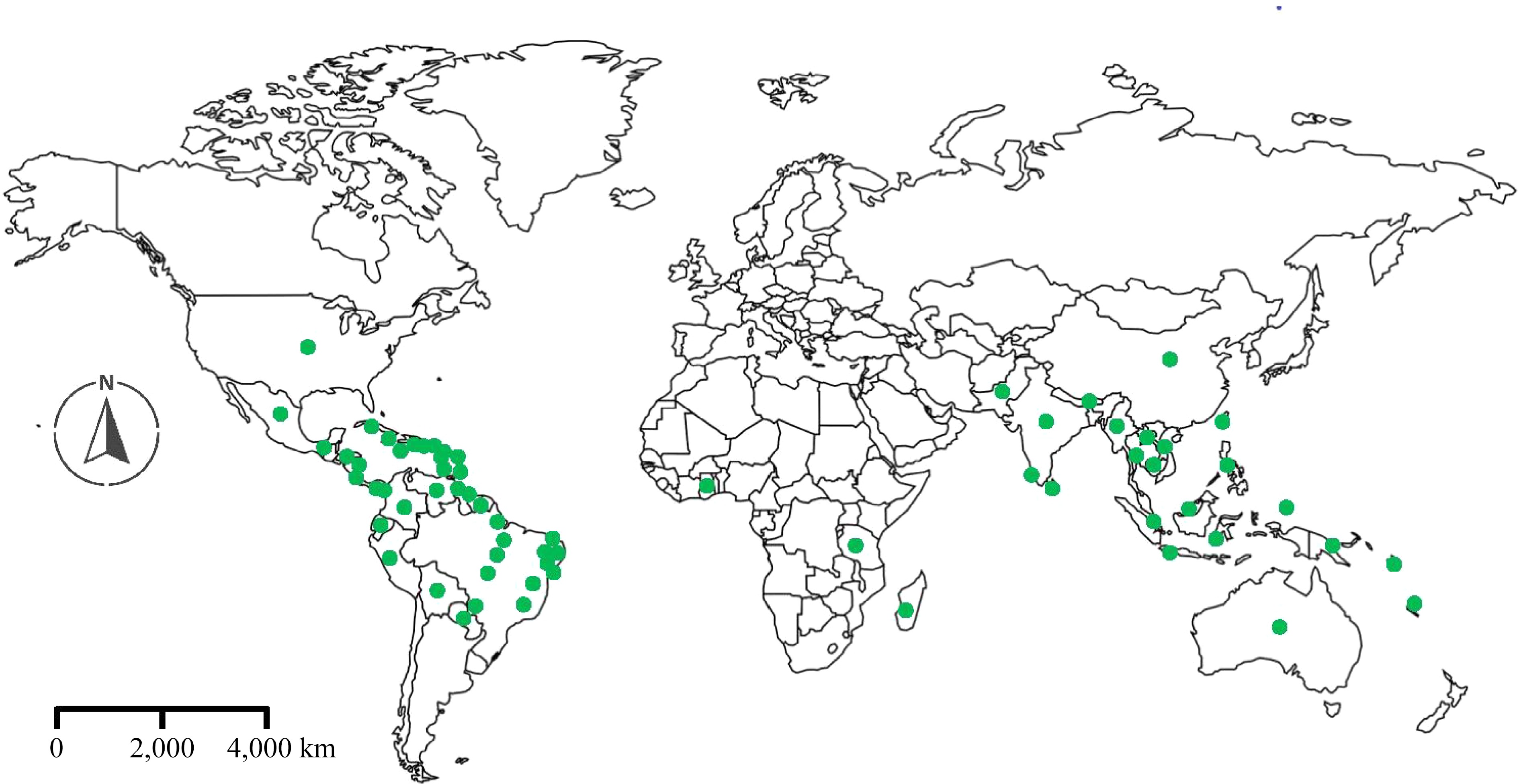-

Figure 1.
Worldwide distribution of A. muricata. Source: adapted from Datiles & Acevedo-Rodriguez[12].
-

Figure 2.
(a) One-month old soursop seedlings, (b) 6-month old seedlings transplanted on a Eutric Silandic Andosol (Loamic) in a humid tropical forest environment with mean annual rainfall of about 3,100 mm, mean annual temperature of 25.2 °C, and mean annual relative humidity of > 85%, (c) 28-month old soursop tree and (d) a mature soursop fruit.
-
Climatic characteristic Suitability class Optimal Moderate Marginal Mean annual temperature (°C) 22−25 18−21 < 12, > 26 Mean annual rainfall (mm) 2,000−2,500 1,000−1,500 < 1,000 Relative humidity (%) 70−80 50−60 < 50 Altitude (m a.s.l.) 200−300 300−1,000 < 200; > 1,000 Soil temperature (°C) 25 - 35 10−25 < 10 Soil moisture regime Udic Perudic Aquic, Peraquic, Aridic, Ustic Soil temperature
regime (50 cm soil depth from surface)Hyperthermic/
IsohyperthermicThermic/
IsothermicMesic/Isomesic Definitions of soil temperature and moisture regimes are based on Soil Survey Staff[54]. Table 1.
Climatic characteristics influencing the growth of A. muricata.
-
Substrate Effect on
seedling growthRef. 50% soil + 25% humus + 25% carbonized rice husk + [72] Soil + vermicompost + mineral fertilizer + [73] Soil + humus + dried coconut shell powder + [74] 25% cattle manure + 75% vermiculite + [67,68] 50% cattle manure + 50% vermiculite + [67,68] 50% vermiculite + 50% carbonized rice husk + [75] 50% vermiculite + 50% earthworm humus + [75] 42%−50% soil + 42%−50% cured bovine manure + 0.04%−0.07% lime + 0.05%−0.08% single superphosphate + [76] 20% soil + 40% cattle manure + 20% sand + 20% vermiculite + [77] Soil + AMF + 10% vermicompost + [78] Soil + AMF + cocoa shell compost + [79] Soil + AMF +10 t ha−1 rice husk biochar + [80] 77% topsoil + 23% saw dust + [81] 50% topsoil + 50% sawdust + [82] 33.3% garden soil + 66.77% fine river sand + [83] 82% soil + 15% sand + 3% bovine manure + [69] 50% soil + 25% coconut shell powder + 25% carbonized rice husk − [72] Soil + green coconut husk powder − [74] 25% earthworm humus + 75% cassava branches − [68] 50% earthworm humus + 50% cassava branches − [68] 25% bovine manure + 75% cassava branches − [68] +: positive effect on seedling growth. −: negative effect on seedling growth. AMF: Arbuscular mycorrhizal fungi. Table 2.
Some substrate combinations influencing seedling growth of A. muricata.
-
Soil characteristics Suitability class Optimal Moderate Marginal Physical characteristics Textural class# Loam,
sandy loam,
loamy sand,
sandy clay loamClay loam, sandy clay, silty clay,
silty clay loam,
silt loamHeavy clay, clay Depth (cm) > 180 cm < 180 cm −
Chemical characteristicsSoil pH 5.5−6.5 5.0−5.5 < 5.0 Soil organic matter (%) > 6% < 6% − Base saturation (%) > 60% < 60% − Al saturation (%) < 20% > 20% − #: The texture is based on USDA textural triangle[54]. Table 3.
Soil characteristics, limits and degree of suitability for A. muricata.
-
Edaphic characteristics Recommended value Climatic characteristic Mean annual temperature (°C) 22−25 Mean annual rainfall (mm) 2,000−2,500 Relative humidity (%) 70%−80% Altitude (m a.s.l.) 200−300 Soil temperature (°C) 25−35 Soil moisture regime Udic Soil temperature regime
(50 cm soil depth from surface)Hyperthermic/
IsohyperthermicSoil physical characteristics Textural class# Loam, sandy loam,
loamy sand,
sandy clay loamDepth (cm) > 180 cm Soil chemical characteristics Soil pH 5.5−6.5 Soil organic matter (%) > 6% Base saturation (%) > 60% Al saturation (%) < 20% Table 4.
Recommended edaphic requirements for cultivating A. muricata.
Figures
(2)
Tables
(4)